Best salt mixes for saltwater fish/reef aquariums & salinity control guide
Keeping a saltwater aquarium can indeed be more challenging than a freshwater one. Aside from making sure proper pH is maintained, you also have to make sure the right amount of substances like calcium is present in the water. The survival of captive reef invertebrates in your tank is dependent on how persevering and tenacious you are in maintaining the proper salinity and salt compositions of the water. Here are some tips to make sure you have the proper salt mix to achieve the ideal salinity for your reef tank:
- Ideal water parameters for saltwater aquariums
- The Best Salt Mix for Saltwater Aquariums
- Instant Ocean Reef Crystals, Enriched Formulation
- Instant Ocean Sea Salt, Nitrate & Phosphate-Free
- Red Sea Fish Pharm Coral Pro Marine Salt
- Brightwell Aquatics NeoMarine Marine Salt Blend
- Fritz Aquatics Reef Pro Mix Complete Marine Salt
- Kent Marine Sea Reef Salt Mix
- Seachem Vibrant Sea Highly Concentrated Synthetic Sea Salt
- How to mix saltwater for reef tanks?
- Aquarium salinity meters/testers
- How to maintain the ideal water salinity and quality?
Ideal water parameters for saltwater aquariums
| Parameters | Reef Aquarium | Fish-Only Aquarium | Natural Coral Reefs |
| Salinity | 1.023-1.025 | 1.020-1.025 | 1.025 |
| Temperature | 72-78℉ | 72-78℉ | 80-82℉ |
| pH | 8.1-8.4 | 7.9-8.5 | 8.0 – 8.5 |
| Alkalinity | 8 – 12 dKH | 8 – 12 dKH | 6 – 8 dKH |
| Ammonia (NH3) | 0 ppm | 0 ppm | ~0 ppm |
| Nitrite (NO2) | 0 ppm | 0 ppm | ~0 ppm |
| Nitrate (NO3) | < 1.0 ppm | < 30 ppm | .25 ppm |
| Phosphate (PO4) | < 0.2 ppm | < 1.0 ppm | 0.13 ppm |
| Calcium (Ca) | 350 – 450 ppm | 350 – 450 ppm | 380 – 420 ppm |
| Magnesium (Mg) | 1250 – 1350 ppm | 1150 – 1350 ppm | 1300 ppm |
| Iodine (I) | 0.06 – 0.10 ppm | 0.04 – 0.10 ppm | 0.06 ppm |
| Strontium (Sr) | 8 – 14 ppm | 4 – 10 ppm | 8 – 10 ppm |
Salinity
Salinity is the measure of the concentration of dissolved salts (ions) in water. Normal seawater is about 3.5% salt and 96.5% water by weight. Salinity is often given in ppt – parts per thousand. A salinity of 35 ppt (part per thousand) is just another way to say 3.5% salt. (35 ÷ 1000 = .035 then multiply by 100 to convert to percent = 3.5%).
There are a number of methods used to measure salinity: refractometers, hydrometers, and conductivity probes. These devices typically report values for specific gravity (sg) or salinity (ppt) and less commonly used conductivity (milli Siemens (mS) per centimeter (cm)).
For fish-only aquariums, there is quite a bit of flexibility here as fish do well in a range between 1.020-1.025 (or 28.4 – 35 ppt at 76°F). Corals, on the other hand, prefer a consistent salinity of 1.023-1.025 (or 32.3 – 35 ppt at 76°F).
Don’t worry too much about small deviations; salinity is fairly forgiving in most reef tanks. If the salinity is too high, you can lower it by removing some of the tank water and replacing it with just RO/DI water. If too low you can add more salt mix.
Do know that altering salinity significantly does alter the alkalinity, amounts of calcium, magnesium, and other ions to the point where they will need adjustments.
Temperature
Temperature is important for both coral and reef fish as they are all tropical creatures. However, they both require consistent temperatures ranging from 72-78°F. A few species from equatorial or warmer regions like the Red Sea may prefer temperatures as high as 82°F.
pH
Your pH is the measure of acidity (free hydrogen ions). The more H+ there is in the water, the lower the pH will measure. Fortunately, between all of the minerals in the water, a crushed aragonite substrate, and active coral skeleton formation, marine reefs maintain an average pH of between 8.0-8.5, which is perfect for both fish and corals!
Alkalinity
Alkalinity is a measure of how effective your water is at neutralizing acids, which have a drastic impact on pH. The higher your alkalinity the more buffering capacity it has against acidity. In the aquarium industry, total alkalinity may be referred to as “carbonate hardness” or “KH.”
Natural seawater has an alkalinity of 6 – 8 dKH. However higher alkalinity levels (8-12 dKH) are beneficial to SPS and LPS corals by promoting rapid growth. Bicarbonate dosing (HCO3-) is used in addition to what’s already present in marine salts in many reef setups. Calcium reactors, which add calcium and bicarbonate, are a common way to add alkalinity to a system.
Ammonia (NH3)
Ammonia is both a breakdown byproduct of organic matter (typically proteins) as it’s consumed by bacteria as well as a waste product released by fish and other aquatic organisms. It is the first step in the aquarium nitrogen cycle that ends with either nitrate or nitrogen gas (N2), depending on the efficiency of your filtration.
Ammonia is food for nitrifying bacteria but poisonous to most higher organisms, including fish and coral. In the wild, the vastness of the ocean prevents ammonia levels from ever reaching toxic levels. But in an aquarium, we need to be proactive in its processing and removal.
Regardless of your aquarium inhabitants, FOWLR (fish only with live rock), soft corals, LPS (large polyp stony), or SPS (small polyp stony) corals, ammonia concentrations should be as close to 0 ppm as possible.
Nitrite (NO2)
In an aquarium with active nitrifying bacteria, ammonia gets reduced to nitrite after being consumed. Nitrite is less poisonous to aquatic organisms than ammonia but still a problem for both fish and invertebrates.
In marine ecosystems we want nitrite to be at 0 ppm as it’s quite toxic to both fish and invertebrates. No nitrite readings are the sign of a healthy biological filtration capacity and a mature aquarium.
Nitrate (NO3)
Nitrate is a bit of a puzzle at times because it’s both a pollutant and an important nutrient. Nitrate is the final form nitrogen from biological processes takes unless removed via water changes, uptaken by plants, or reduced further by anaerobic (oxygen-hating) denitrifying bacteria into nitrogen gas.
Nitrate is the least toxic of the three forms but in high enough concentrations it can interfere with the respiration of fish by depriving them of oxygen. That said, fish are tolerant of levels below 30 ppm.
Invertebrates are more problematic as they tend to be more sensitive to nitrate. If you’re keeping more sensitive LPS or SPS corals, nitrate should be at around 1 ppm or less. However, certain LPS and many soft corals prefer levels of around 5 ppm or less.
Some corals actually need nitrate/nitrite as a source of food for their zooxanthellae. Without nitrate to use, their growth can actually halt. Many soft corals, such as Pulsing Xenia and Kenya Tree Coral, will stall out or die in ultra-pure SPS reefs because they prefer higher concentrations of nitrate to survive.
Nitrate, being an algae nutrient, can also cause filamentous and macroalgae to grow. Combined with intense reef lighting, they can quickly smother your corals.
Phosphate (PO4)
Phosphate is an important nutrient for algae and plants found in seawater at a concentration of around 0.07 ppm. In low concentrations like this, it provides a steady but slow source of nutrition for macroalgae, zooxanthellae, and other marine plants.
However, their levels tend to become elevated in marine aquariums, especially in tanks that have fish. Phosphates are found in fish food as preservatives (polyphosphates) and their concentration can reach high enough levels that algae blooms occur.
Like nitrate, we don’t actually want 0 ppm but we do want concentrations to remain very low in the reef aquarium. Less than 0.2 ppm is ideal for reef systems; in a FOWLR tank, <1 ppm is a good reading.
One of the best ways to manage phosphate concentrations is to set up a refugium, which contains macroalgae that consume it (as well as nitrate). It can eventually be harvested to feed algae-eaters like Tangs and Angelfish or simply tossed out to remove phosphate entirely.
Calcium (Ca)
Calcium is incredibly important for reef systems because it’s one of the building blocks of coral structure. Aragonite (CaCO3) is created by most SPS, LPS, and even many soft corals to hold themselves erect.
Calcium concentrations on natural reefs are generally between 380 – 420 ppm and highly constant within this region. Therefore, many reef aquarists automate the addition of calcium by using calcium reactors and other constant sources of the element. Marine salt mixes contain enough calcium at first to meet coral needs but this quickly gets depleted without supplementing.
Fluctuations in calcium can interfere with coral growth, which is slow but constant. In the home aquarium concentrations of 350 – 450 ppm are best, with the higher end helping to fuel even faster coral growth in many species. Fish-only setups are more tolerant of both low levels and fluctuations. But both fish and invertebrates like shrimp and clams still need calcium from the water for growth.
Magnesium (Mg)
Magnesium’s role in water chemistry is to allow both calcium and carbonate concentrations to remain high and stable in saltwater. Without magnesium to increase the saturation potential of your water, calcium and carbonate levels will fall below the levels corals need for growth.
In nature, magnesium levels hover right at around 1300 ppm, making it the third most common element after sodium and chloride. Corals do uptake magnesium and incorporate it into their skeletons so supplementation is needed, depending on your water changing regimen. However, fish only need what’s already available in your marine salt mix, which gets replenished each time you perform a water change.
Iodine (I)
Iodine is an essential trace element found in seawater at concentrations of .06 ppm. It’s used by animals to aid in nutrient transfer within cells as well as healthy hormone and pigment production. Since corals can be damaged by the intense lighting they require, iodine is especially important for forming protective pigments that block DNA damaging radiation.
However, dosing iodine is rarely needed since it’s found in the right concentrations in most marine salt mixes. Iodine is also toxic in higher concentrations so unless you’re certain you have a deficiency it’s best not to add any more.
Strontium (Sr)
Like Calcium and Magnesium, Strontium is used by corals in the construction of their skeletons. Since increasing the concentration seems to boost growth, many reef aquarists use slightly elevated levels (8 – 14 ppm) compared to natural seawater (8 – 10 ppm). Strontium does not need to be measured in FOWLR tanks. Any trace function it serves in fish will be replenished through water changes.
The Best Salt Mix for Saltwater Aquariums
Instant Ocean Reef Crystals, Enriched Formulation

 Check on Amazon #ad
Check on Amazon #ad
Instant Ocean Reef Crystals sea salt is one of the main brands reef aquarists use when performing water changes. Found in pet stores worldwide it’s an excellent product to always keep on hand. What really catches our attention is the enrichment formulation Instant Ocean uses, which makes it ideal for reef aquariums.
Rather than just replicating natural water chemistry, they’ve included higher concentrations of essential elements like calcium and magnesium to spur faster coral growth. Their FOWLR formula has lower concentrations of these elements which are enough for fish but not ideal for corals. Reef Crystals also include additives that neutralize toxic heavy trace metals occasionally found in tap water.
Instant Ocean Sea Salt, Nitrate & Phosphate-Free

 Check on Amazon #ad
Check on Amazon #ad
Instant Ocean Sea Salt is formulated to be free of nitrates and phosphates which, as we’ve discussed earlier, are major pollutants in marine aquariums. However, it still includes all of the major trace elements, including strontium, calcium, and magnesium, which makes it different from standard aquarium salt. The added minerals will buffer the water towards alkalinity, which we want.
The levels of trace and major elements aren’t in ratios designed to maximize coral growth. That said, extra calcium can be easily dosed to make up for the deficits!
Red Sea Fish Pharm Coral Pro Marine Salt

 Check on Amazon #ad
Check on Amazon #ad
One aspect of Red Sea’s approach that we love is that they are much more open with their formulation. You need to contact Instant Ocean directly if you want a copy of a lab analysis. This is nice but Red Sea prints the exact parts per million of major elements directly onto the box based on how many ppm of salt you add.
Even more information is available on their website, which tells us they provide elevated levels of strontium, which is a trace but significant element for stony corals. Red Sea Fish Pharm also comes in smaller amounts, making it especially convenient for nano and pico reef tanks.
Brightwell Aquatics NeoMarine Marine Salt Blend

 Check on Amazon #ad
Check on Amazon #ad
Brightwell Aquatics uses an ultrapure salt blend formulated to dissolve into precise marine ratios for both fish and corals. All major and minor trace elements are included and their salt is free of nitrates, phosphates, and ammonia. The company is so confident about their formulation that their salt is even rated food-grade by the USDA, something none of the other formulas can boast!
Fritz Aquatics Reef Pro Mix Complete Marine Salt
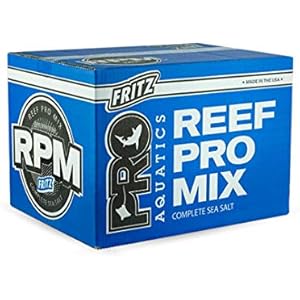
 Check on Amazon #ad
Check on Amazon #ad
Fritz Aquatics uses a formulation with enhanced buffering capacity. This prevents drastic pH swings after performing water changes and helps keep your parameters stable for coral growth. All of their major and minor trace element parameters are on the middle to higher end of the scale as well, making this an ideal salt for reef aquariums.
Kent Marine Sea Reef Salt Mix
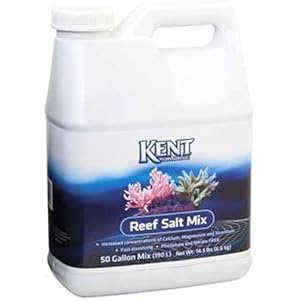
 Check on Amazon #ad
Check on Amazon #ad
Kent adds higher than seawater standards of calcium, magnesium, and strontium to help corals grow faster than normal. Since Kent Marine makes their products in small batches they guarantee consistent chemistry despite their volume of salts. And like the best marine salts, it’s entirely free of nitrates and phosphates!
Seachem Vibrant Sea Highly Concentrated Synthetic Sea Salt

 Check on Amazon #ad
Check on Amazon #ad
As a well-balanced reef sea salt, Seachem Vibrant matches the levels of magnesium, calcium, and strontium to natural sea water for optimal fish, coral, and invertebrate health. Balanced magnesium levels ensure calcium remains continually available for coral growth. Another benefit Seachem Vibrant Sea provides is elevated levels of potassium, an element corals use for the production of red pigments. Using Seachem Vibrant can bring out these colors in your corals!
How to mix saltwater for reef tanks?
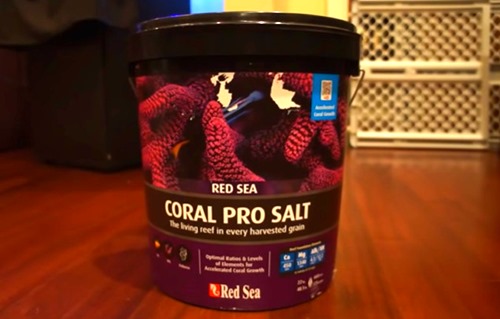
Unless your tank residents are from an environment you know to be substantially different from that of natural seawater, like brackish with a lower salinity or from the Red Sea that has a higher salinity, mixing to 35ppt salinity will be adequate for most tanks.
You will need a mixing container that holds at least 5 to 10 percent of the volume of water your display tank holds – i.e. if you have a 100-gallon tank, your container needs to have the ability to hold at least 5 – 10 gallons. Containers can be of any size but the larger it is, the more constant your mix will be in its parameters. Old aquariums, clean storage containers, and new garbage cans are popular choices.
Fill the container with your RO/DI freshwater. It’s a good practice to aerate RO water for 12-24 hours before mixing in the salt. This will help drive off excess CO2 so you get a proper pH and buffering capacity in your mixed seawater.
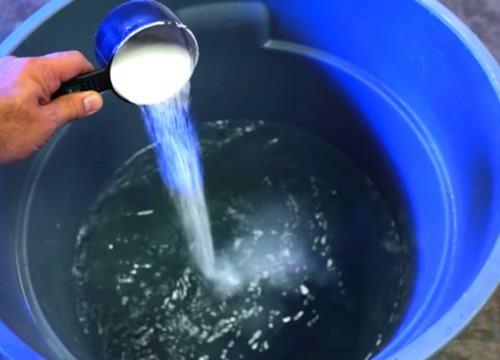
Add the salt following the manufacturer’s instructions. Your freshly mixed seawater is very caustic and needs time to cure, a minimum of 24 hours before it can be used in your aquarium. While it cures, use an air stone or powerhead in the water to circulate and aerate the mixture and put in a heater to make it match the water temperature of your display tank.
You want to match the mixing tank salinity to that of your aquarium. Use a refractometer to measure the salinity and adjust accordingly. Based on your tank’s species, salinity should be 28 to 35 parts per thousand (ppt), or 1.020 to 1.025 specific gravity.
If you want to add any calcium, magnesium, alkalinity, or anything else, add it after the salt has dissolved.
You spend a lot of time and money on your tank. Having extra saltwater ready to use provides extra insurance for those unforeseen accidents and the minimal investment in a container, powerhead, and heater is well worth the small cost and effort.
Mixed artificial seawater can be stored for as long as needed without continuous stirring or heating when made from adequately pure freshwater.
Aquarium salinity meters/testers
Once you decide to keep a reef tank, be prepared to spend more on some gadgets that you will use to test the salinity of the water. This gadget is as important as the tank itself because if you’re not able to measure the water’s salinity, all your tank creatures will die and you can forget the whole thing. Seriously, it’s important that you are able to constantly check the water salinity so that it doesn’t get too low.
You can use a refractometer or a hydrometer to measure the salinity.
1. Refractometer
 Hand-held salinity refractometer #ad
Hand-held salinity refractometer #ad
 Milwaukee Digital Salinity Refractometer #ad
Milwaukee Digital Salinity Refractometer #ad
Many reef keepers use the refractometer to accurately measure the amount of dissolved salt in the water. A refractometer evaluates water salinity through the refraction of light which can be done even with just a tiny water sample. The refractometer can give the precise measurement of salinity and you’ll see the numbers displayed on its small screen.
2. Hydrometer
 Coralife Energy Savers Hydrometer #ad
Coralife Energy Savers Hydrometer #ad
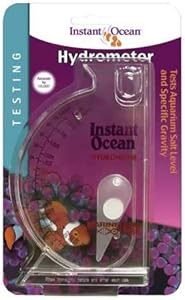 Instant Ocean SeaTest Hydrometer #ad
Instant Ocean SeaTest Hydrometer #ad
Another more traditional and reliable instrument to use for measuring salinity is the hydrometer which measures the water’s gravity or density. Freshwater weighs 1.000 grams per liter, and when the salt mix is added to it, the salinity should increase the water’s density to not more than 1.025. This makes it easier for you to know if your tank has just the right salt mix enough for the corals, the fish, and all the sea creatures to stay alive and healthy.
How to maintain the ideal water salinity and quality?
Supplement evaporated water
Now that you’re done with getting the correct salt mix and achieving the ideal salinity, the next thing to do is to maintain that ideal salinity. That takes patience because, in the first place, whenever water evaporates, it leaves the salt and substances in the tank. This will result in increased salinity and if that happens, your tank will no longer be an ideal reef environment, and you will soon see your fish and corals weaken and eventually die.
The best way to ensure your tank has the appropriate salinity is by using an auto topping off system. This helpful system does its job by replacing the evaporated water with fresh water to maintain the constant water level in the tank as well as the ideal salinity of the water. Make sure you use distilled water or reverse osmosis water to add to the auto topping off system.
Replenish depleted resources
Take note that your aquarium creatures use the substances of the salt water for their live activities that makes these substances become depleted over time and need to be supplemented. You can replenish the depleted resources with commercial substances. Using an aquarium dosser with multi-dosing pumps helps to automate the process.
Partial water changes
Changing partial old water is the easiest way to maintain the quality of your aquarium water. You need to measure the salinity of your tank and any new seawater you make before adding it to your tank. The water used in this case is the already-mixed salt water done in the same way as the guide in the previous section.
Before changing your aquarium water, measure and record the specific gravity. Make sure the new saltwater matches the specific gravity of your aquarium. Too much of a deviation in salt levels could “shock” or potentially kill sensitive aquarium inhabitants.

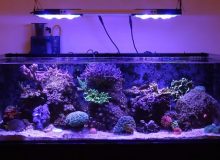
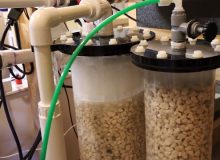
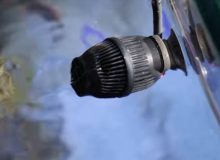
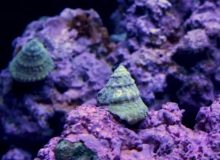
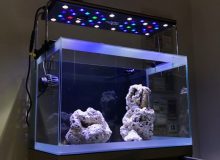
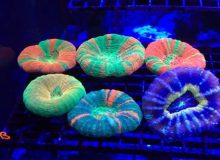
Leave a Reply